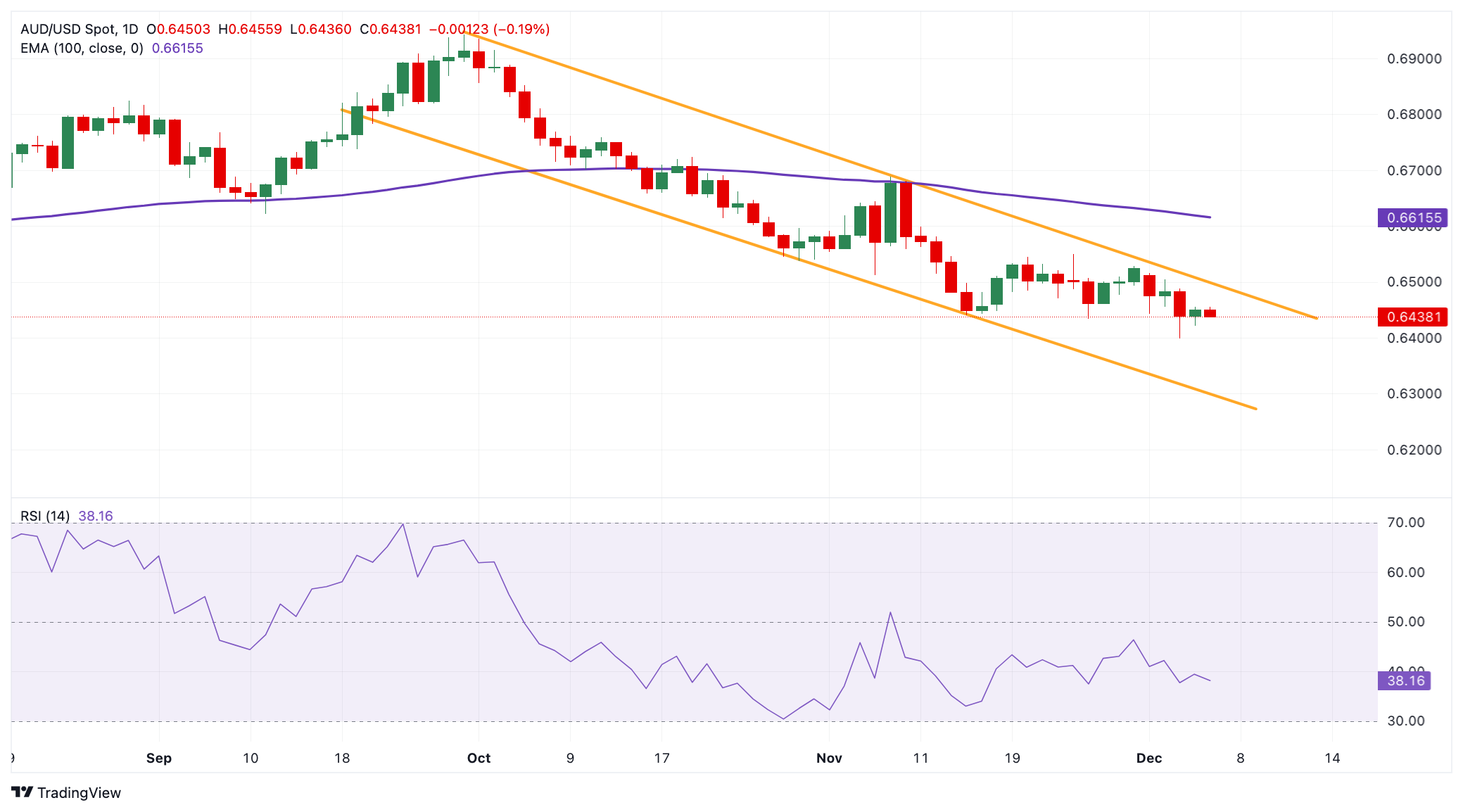Australian Dollar attracts some sellers ahead of US NFP release

- The Australian Dollar attracts some sellers in Friday’s Asian session.
- Discouraging GDP numbers sparks the RBA rate cut bets, weighing on the Aussie.
- The US Nonfarm Payrolls report will take center stage on Friday.
The Australian Dollar (AUD) edges lower on Friday. Disappointing economic growth could prompt the Reserve Bank of Australia (RBA) to adopt a more dovish tone at next week’s monetary policy meeting, potentially setting up a February rate cut. This, in turn, exerts some selling pressure on the Aussie.
Traders will closely monitor the US November employment report, including Nonfarm Payrolls (NFP), Unemployment Rate and Average Hourly Earnings. The US economy is expected to see 200,000 jobs added in November after rising by 12,000 in October. In case of weaker than estimated outcome, this could drag the Greenback lower and create a tailwind for AUD/USD.
Australian Dollar loses momentum amid uncertainties
- A Reuters poll of 44 economists showed the RBA is expected to keep the cash rate unchanged at 4.35% in the next meeting and see the RBA cut rate by 25 bps to 4.10% in Q2 2025 (vs Q1 in the November poll).
- Australia’s GDP expanded 0.3% QoQ in the three months through September, compared with the 0.2% growth in the second quarter. This reading was below the market consensus of 0.4%.
- The US weekly Initial Jobless Claims rose 9,000 to 224,000 for the week ending November 29, according to the US Department of Labor (DoL) on Thursday. This reading came in above initial estimates and higher than the previous week’s 215,000.
- Continuing Jobless Claims went down by 23K to 1.871M for the week ending November 22.
- The Fed Chair Jerome Powell stated on Wednesday that the US economy is stronger now than the US central bank had expected in September when it began reducing interest rates, which means the US central bank can show some restraint in cutting interest rates.
AUD/USD’s bearish bias remains unchanged in the longer term
The Australian Dollar trades weaker on the day. The AUD/USD pair keeps the bearish vibe on the daily chart as the price is below the key 100-day Exponential Moving Average (EMA). The 14-day Relative Strength Index (RSI) is located below the 50-midline near 38.85, indicating bearish momentum. This suggests that the path of least resistance is to the downside.
The potential support level emerges at 0.6300, representing the lower limit of the descending trend channel and psychological level. Bearish candlesticks below this level could draw in more sellers to 0.6285, the low of October 3, 2023.
Sustained bullish momentum above the upper boundary of the trend channel of 0.6500 could see a rally to 0.6615, the 100-day EMA. A decisive break above the mentioned level could expose 0.6687, the high of November 7.
Fed FAQs
Monetary policy in the US is shaped by the Federal Reserve (Fed). The Fed has two mandates: to achieve price stability and foster full employment. Its primary tool to achieve these goals is by adjusting interest rates. When prices are rising too quickly and inflation is above the Fed’s 2% target, it raises interest rates, increasing borrowing costs throughout the economy. This results in a stronger US Dollar (USD) as it makes the US a more attractive place for international investors to park their money. When inflation falls below 2% or the Unemployment Rate is too high, the Fed may lower interest rates to encourage borrowing, which weighs on the Greenback.
The Federal Reserve (Fed) holds eight policy meetings a year, where the Federal Open Market Committee (FOMC) assesses economic conditions and makes monetary policy decisions. The FOMC is attended by twelve Fed officials – the seven members of the Board of Governors, the president of the Federal Reserve Bank of New York, and four of the remaining eleven regional Reserve Bank presidents, who serve one-year terms on a rotating basis.
In extreme situations, the Federal Reserve may resort to a policy named Quantitative Easing (QE). QE is the process by which the Fed substantially increases the flow of credit in a stuck financial system. It is a non-standard policy measure used during crises or when inflation is extremely low. It was the Fed’s weapon of choice during the Great Financial Crisis in 2008. It involves the Fed printing more Dollars and using them to buy high grade bonds from financial institutions. QE usually weakens the US Dollar.
Quantitative tightening (QT) is the reverse process of QE, whereby the Federal Reserve stops buying bonds from financial institutions and does not reinvest the principal from the bonds it holds maturing, to purchase new bonds. It is usually positive for the value of the US Dollar.
Macroeconomic data gauges the health of an economy and can have an impact on the value of its currency. Investors prefer to invest their capital in economies that are safe and growing rather than precarious and shrinking. Greater capital inflows increase the aggregate demand and value of the domestic currency. Classic indicators, such as GDP, Manufacturing and Services PMIs, employment, and consumer sentiment surveys can influence AUD. A strong economy may encourage the Reserve Bank of Australia to put up interest rates, also supporting AU
